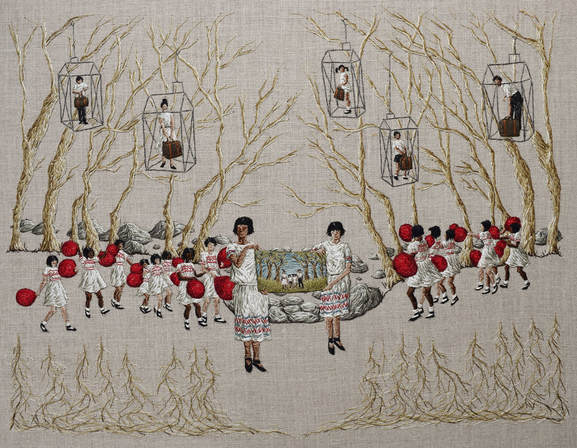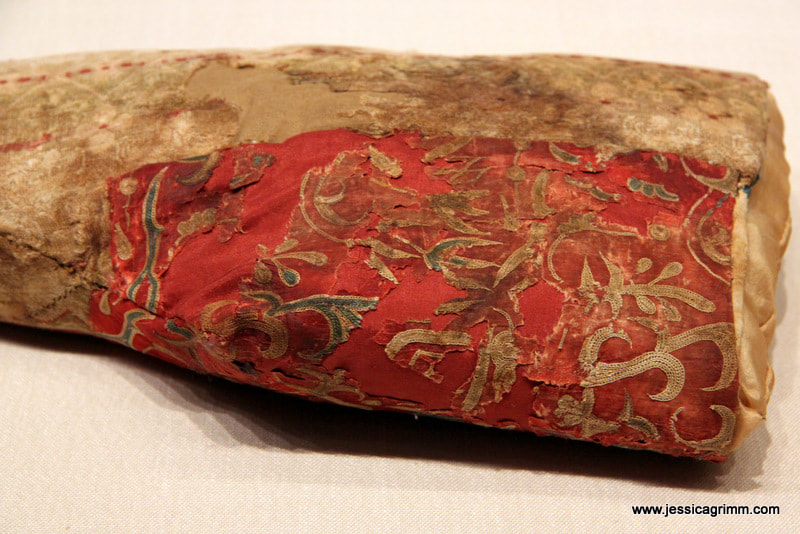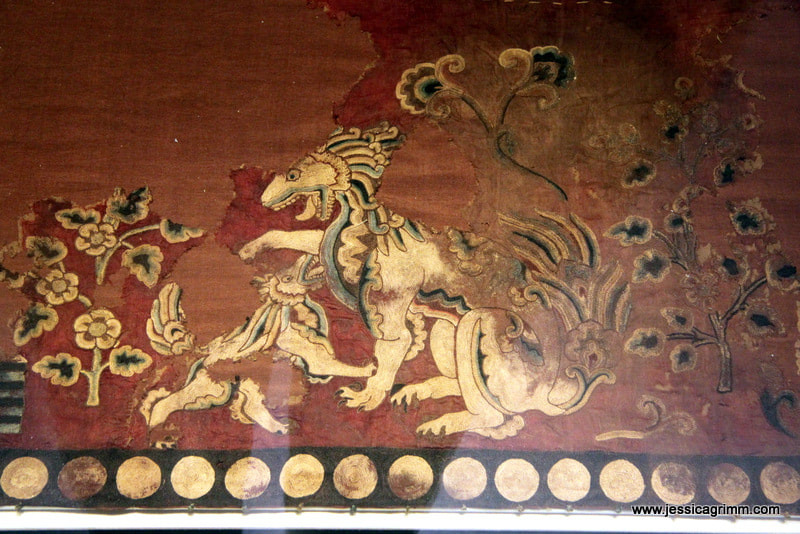|
Those of you who have browsed my website lately will have noticed that I am changing my website around a bit. It is the result of a rather tumultuous year for my embroidery business. What was I up to in 2018? I started the year with a renovated studio. It provides a much better working space for me and for teaching embroidery courses and workshops. Early February, I attended my second high-end craft market. It was such a success that I vowed not to attend another one for the rest of my life... Instead, in May, I was invited to join local artist Marion Werner for an intimate art exhibition at her home. For the entry fee of two batches of mini-muffins, I had the time of my life! With hindsight, I can now say that this event steered my stitching career in a different direction. Away from craft and towards art. It is like growing up, as it comes with growing pains. It proves to be hard to claim the new identity of textile artist... Financially it wasn't a good year for Märchenhaftes Sticken. I barely hit the €10000 mark for my turnover. Normally I am just short of €14000... Ough! Unfortunately, I can't quite explain the financial down-turn. I tried quite a few new things this year to generate extra income. I published a crewel pattern and instead of putting a fixed price on the download, I asked people to pay me through PayPal what they felt the pattern was worth. The pattern was downloaded quite a few times, but I received no payment... Nevertheless, I thought that my PayPal donation button would generate a modest income from all the people who ask for embroidery advice, but don't need anything from my webshop. It is an excellent opportunity for them to not feel guilty as they are being able to express their gratitude financially for the excellent service they have obtained from me. Think I am dreaming? Not all the time :). It worked twice and I am very grateful to these kind and generous persons! Another potential extra income generator was my first ever downloadable ebook and accompanying material packs. It was great fun to research a little known silk embroidery technique from 17th century Italy. However, I had hoped for a slightly better reception of the ebook: I only sold 10 copies. Is it because my readers/groupies/followers are not interested in these kind of things? I don't know. There were 84 people who entered my competition to win a free copy... A total fiasco so far: my online embroidery classes. After having been badgered for years by many people in the embroidery community, I decided to bite the bullet. I invested €611 in software, a video hosting platform and a camera stand. As I turned the projects I was going to teach in China into these online classes, I at least did not have to invest extra time in developing and writing up new projects. Sadly, I have only sold two classes. Interestingly, my gut feeling has always told me that online classes will probably not be successful for me. People think I can offer them real cheap. After all, I am a one-woman-show so I should be much cheaper than let's say Craftsy. After all, they are the real professionals with big studios and a crew. I am only me. How come I cost more? Because I cost them on the bases that I would probably sell no more than 20 classes a year. They cost them on the basis of thousands... Social Media was not my friend this year. After putting an enormous amount of efford into building up an Instagram following, my account got hacked when I was just short of 1000 followers. As I received no help from Instagram/Facebook and after hearing more and more data scandals regarding Facebook, I quit all Social Media (bar Pinterest). You wouldn't believe how many more hours my days suddenly have...! And just like all other bussinesses that deal with the data of Europeans, I had to make my whole business GDPR compliant. Not fun. And expensive too. For me, 2018 was all about traveling in the name of embroidery. In the spring we went to Crete and by chance discovered the beautiful goldwork embroideries at Moni Arkadi. In early September I spent a few days in Vilnius with fellow embroiderer Agne. We visited a beautiful exhibition on embroidered vestments. And then there was my trip to China in October/November. I had a blast teaching a very diverse group of lovely students European embroidery techniques. Very satisfying! So what is in store for 2019? Teaching-wise, I will concentrate on my five-day embroidery courses. They are my preferred teaching format. Online classes have not proven to be successful and one-day workshops don't work very well either as people do not like to travel for such a short event. Of the four workshops planned in 2018, only one took place with two of the possible six students... Likewise I no longer offer Work in Progress Saturdays. This is, like the online classes, a good example of the disparity between what people say they want and what they are prepared to invest in. On the advice of my students I started them two years ago. I was hesitant to start this endeavour as I knew people would not have the discipline to put at least some in their calendars and stick to them. Instead, the Saturdays started to move around at short notice. People pulled out at short notice so that I was forced to only run them when I had a minimum of three students. The end of the story? It ran only once this year with one student. Part of being a profesionall is that you do pull out of projects that don't make sense financially. My biggest challenge for 2019 will be my first-ever solo exhibition at the end of August. You will probably see lots of new work on my blog as I will need to fill two exhibition rooms. Furthermore, I want to concentrate on my blog. It is a lovely way to journal my own journey. And I love researching historical embroideries! Wishing you a happy new year and I hope to 'see' you next week for a blog post on a special Christmas gift I made myself.
28 Comments
Since I've started to define myself as an embroidery artist rather than a craftswoman, I've come across a whole new group of art embroiderers I previously knew nothing about! Especially if you come from the craft-side of embroidery as well, you will be in for a treat! First up is Agnes Herczeg from Hungary. I came across her colourful intricate miniature art through an article in Fiber Art now; the quarterly publication of the Fiber Art Network. Agnes trained as a textile restorer and has great admiration for the skill of needleworkers in the past. Her own pieces are made with needle lace, pillow lace and braiding. She also integrates wood, coconut shell and ceramics. The thread is then painted to great effect with aquarelle. You can tell from the pieces that Agnes's technical skill is superb! You can view more of her work on her website. Another textile artist I discovered through Fiber Art now magazine is Lana Crooks. I think it is because I was an archaeologist specialised in animal bone, that her creations appeal to me a lot. Lana creates skulls from felt and then adorns them with for instance bead embroidery or Victorian hair work. The finished pieces are then placed under those antique glass domes with a wooden base. Like a cabinet of curiosities! Explore her work on her website. I also receive a newsletter from The 62 Group of Textile Artists. Amongst many other things, it contained a link to an article by Amber Butchart: The artificial divide between fine art and textiles is a gendered issue. Well worth a read if you want to explore how needlework was viewed in the distant past and why and how things changed. The same newsletter also contained a link to the BBC4 radio show 'Pursuit of Beauty'. This particular edition (In Stitches) is also hosted by Amy Butchart and explores the works and attitudes of several contemporary embroidery artists. You can listen to the show here. Another embroidery artist featured in the summer issue of Fiber Art now is Michelle Kingdom. I love her style as each piece reminds me of a fairy tale. And just as in many fairy tales there is a darker component, Michelle's embroideries have something creepy too. Looking beyond the mere picture, I am equally intrigued with her unique embroidery technique. Not only does she layer straight stitches to create a sense of depth, she also cleverly makes use of the background fabric by leaving it blank. You can find out more about Michelle Kingdom and her work on her website.
Two cents for your thoughts when you read the above blog title. Highly likely that you now have a picture of these hyper-realistic silk embroideries in your mind :). But that's not what we are going to explore in this blog post. Chinese embroidery is so much more! There's the intricate and colourful embroidery from the many ethnic minorities we will explore in a future blog post. And then there are these magnificent dragon robes worn by the emperor and his close relatives. Equally food for a future blog post. But how did it all began? A question I never really asked myself before I went to China. As an archaeologist I am all too aware that the evidence we have for really old textiles adorned with embroidery is scant. You need very favourable preservation conditions for them to survive. So the mantra instilled in me as an archaeology student: absence of evidence is not the same as evidence of absence, holds very true in the case of ancient textiles. But traveling to China and talking to Chinese embroiderers, the question of how it all began is paramount to them. The humiliation at the hands of the Western powers in the 19th century is still a national trauma. Being the inventor of something which was subsequently adopted by the West, thus counts! The National Silk Museum in Hangzhou has a very modern exhibition on the textiles form the Silk Road. The exhibition includes many textile fragments from recent large scale excavations of tombs. A new exhibition titled 'Countless stitching and marvellous threads' was opened when I taught my workshop at the end of October. Unfortunately, this exhibition has no captions in English (unlike the Silk Road exhibition which is entirely bi-lingual). From what my phone was able to translate, the new exhibition focusses on stitches and how they emerged and developed. Starting with archaeological remains and ending with modern embroideries by contemporary masters. Taking pictures of the embroideries on display posed its own problems. The lighting was understandably dim and flash equally understandably not allowed. Usually not a problem when you are patient and have a steady hand. What was a problem, was the bad quality glass used for the display cases. And the fact that they were very (I mean VERY) dirty from the touching of countless hands. China is this delightful combination of a developing country and a highly digitally developed world nation. This means that they laughed at me when I explained that in my rural village of 1200 people, probably 600 or so don't have a mobile phone, nor an email address. Digital 'illiteracy' is high here and not only among the elderly. At the same time, all 1200 of us would shake our heads in pity at the many Chinese who don't have a private toilet in their home and need to use the public toilet. How to use a museum is something they are in the process of figuring out :). Let's explore the embroideries! The oldest embroideries on display, date to the period of the Han Dynasty (206 BC-220 AD) and the Northern Dynasties (386-581 AD). However, in the publications on embroidery I bought at the museum, it is stated that embroidery already existed in the Xia dynasty (2200-1800 BC). But, this is from oral tradition rather than archaeological finds. The first archaeological evidence seems to date from the late Shang dynasty, around 1300 BC. The above fragment dates from the much later Han Dynasty (206 BC-220 AD) and shows longevity symbols stitched with several colours of silk using chain stitch on a red silk background. This small fragment is all that is left from an all-over embroidered female dress. Other embroidered items include a pair of red socks from the first-third century AD. The stitch used seems to be very fine chain stitch. And here is a piece with goldwork embroidery (couching) depicting animal masks and dating to the Northern Dynasties (386-581 AD). This very large piece depicting lions dates from China's golden age, the Tang dynasty (7th century AD). This lovely piece is an embroidered leather pouch with twill damask and samite border. It dates to the Liao dynasty (907-1125 AD). The upper part is a twill damask border, the middle is of leather, completely covered with chain stitch embroidery, with different patterns on each side: birds, butterflies and peonies on one side and flying birds and hunting motifs on the other.
P.S. If you are interested in the history of Chinese embroidery, I recommend the book 'Silken Threads. A history of embroidery in China, Korea, Japan and Vietnam' written by Young Yang Chung in 2005, ISBN 0-8109-4330-1. This is an epic volume with beautiful pictures and of the highest scientific standard. |
Want to keep up with my embroidery adventures? Sign up for my weekly Newsletter to get notified of new blogs, courses and workshops!
Liked my blog? Please consider making a donation or becoming a Patron so that I can keep up the good work and my blog ad-free!
Categories
All
Archives
July 2024
|
Contact: info(at)jessicagrimm.com
Copyright Dr Jessica M. Grimm - Mandlweg 3, 82488 Ettal, Deutschland - +49(0)8822 2782219 (Monday, Tuesday, Friday & Saturday 9.00-17.00 CET)
Impressum - Legal Notice - Datenschutzerklärung - Privacy Policy - Webshop ABG - Widerrufsrecht - Disclaimer
Copyright Dr Jessica M. Grimm - Mandlweg 3, 82488 Ettal, Deutschland - +49(0)8822 2782219 (Monday, Tuesday, Friday & Saturday 9.00-17.00 CET)
Impressum - Legal Notice - Datenschutzerklärung - Privacy Policy - Webshop ABG - Widerrufsrecht - Disclaimer















 RSS Feed
RSS Feed